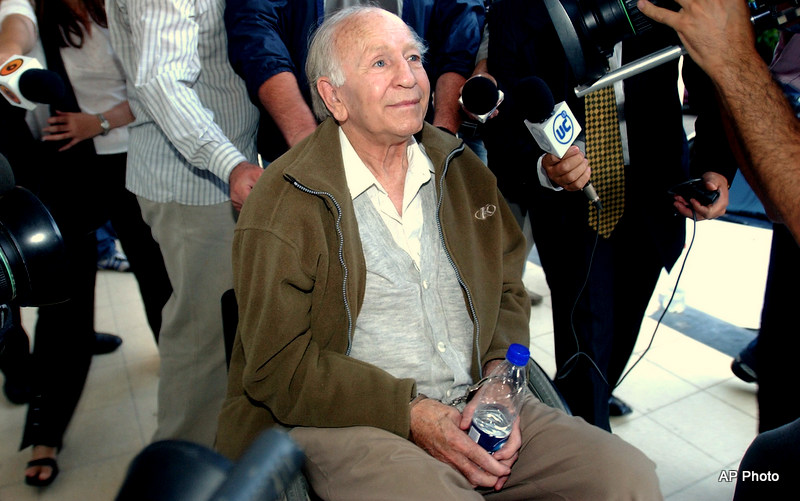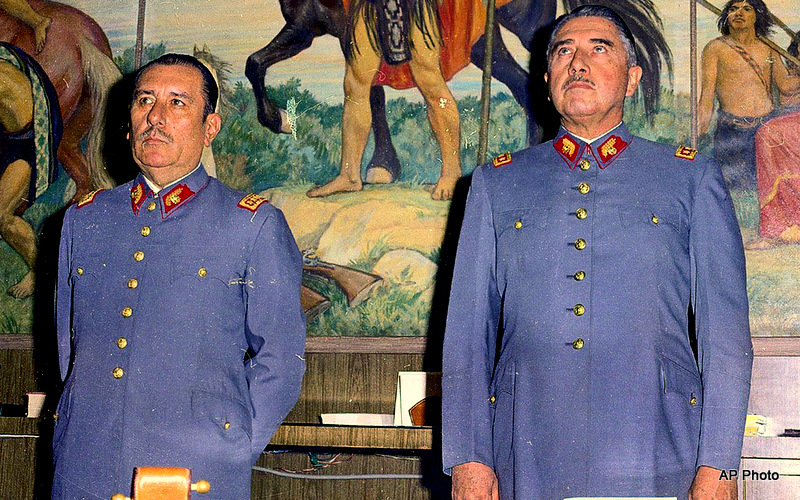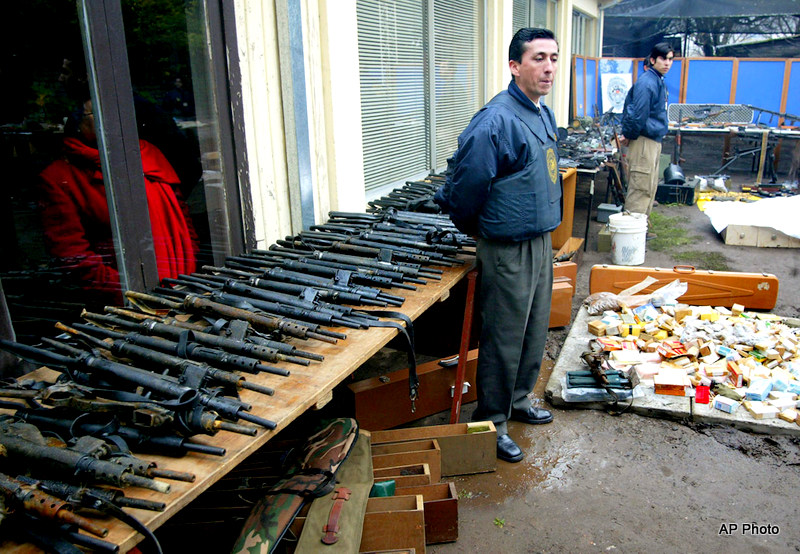Ongoing investigations into human rights violations committed during Augusto Pinochet’s U.S.-backed dictatorship in Chile between 1973 and 1990 have led Judge Mario Carroza to visit the former detention and torture center known as Colonia Dignidad (“Dignity Colony”), later renamed Villa Baviera (Villa Bavaria).
According to Chilean news website La Informacion, Carroza has initiated a search for documents pertaining to the dictatorship’s practice of torturing political detainees. The visit to Colonia Dignidad on Oct. 23 was carried out in collaboration with the Investigation Brigade for Human Rights and the Chilean Investigations Police.
Colonia Dignidad — a detention and torture center with links to the extermination center Cuartel Simon Bolivar — has largely escaped attention despite the magnitude of the crimes carried out there, including the sexual abuse of detained minors, as well as its links to the manufacture of biological and chemical weapons involving CIA agent and National Intelligence Directorate (DINA) agent and collaborator Michael Townley.
Various human rights groups and organizations of activists, the relatives of those who were tortured and “disappeared,” and torture survivors are pressuring the Chilean government for an end to oblivion. One such organization, Londres 38, Espacio de Memoria, released a statement in August, asserting the importance of investigating crimes committed at Colonia Dignidad.
“On the grounds of the former Colonia Dignidad, evidence of crimes still exist. We demand that the state, the government and the judiciary investigate the files that have remained hidden, reported by the media through accurate testimony,” the statement says.
It also calls for an end to the secrecy surrounding testimony related to torture in detention centers obtained by the Valech Commission — an investigation ordered by Chilean President Ricardo Lagos between 2003 and 2005 , as well as the lifting of restrictions pertaining to the Rettig Commission report in 1991, commissioned by President Patricio Aylwin, which focused on detainees who were murdered or “disappeared.”
The state’s collaboration with dictatorship impunity remains a major obstacle in the struggle for memory, as center-left governments have also failed to constructively challenge the legacy bequeathed by Pinochet. To challenge impunity, Londres 38 initiated a campaign demanding an end to oblivion and the opening of secret archives that enable the majority of former DINA agents and torturers to avoid justice and, in many cases, continue to hold influential positions in society.
A German on the run

In 2005, a file was discovered in Colonia Dignidad pertaining to the dictatorship era. It details DINA’s communication structures and includes a register of detained and “disappeared” political prisoners. Most of the information coincides with DINA’s strongest years, from 1974 to 1978. The file also establishes an important link between DINA and Colonia Dignidad.
Founded and run by Paul Schäfer, Colonia Dignidad was an agricultural commune of German settlers in the south of Chile. It was ruled by depravity and operated as a cult that combined religion, abuse and oppression.
Schäfer had fled West Germany amid accusations of child molestation in 1959. After resurfacing in Chile in 1961, he founded the commune and he also took up other initiatives, such as torture instruction, in collaboration with former Nazi officials — including Martin Bormann and Josef Mengele, according to some sources.
Given the long history of military cooperation between Germany and Chile, Schäfer provided Pinochet with a perfect opportunity to expand the horrors and terror of his dictatorship. As Bruce Falconer states in his essay, “The Torture Colony”: “Paul Schaefer needed political allies and protection for his eccentric community; Pinochet’s agents needed discreet services and a secure base of operations.”
In 1997, Schäfer fled Chile, again amid sexual abuse charges. He was apprehended in Argentina on March 10, 2005 and transferred to Chile, where he was sentenced to 20 years in prison for sexual abuse of minors. His death on April 24, 2010 is reminiscent of other dictatorship collaborators’ retention of impunity. And Colonia Dignidad remains a festering wound for Chileans involved in the struggle for memory, in particular with regard to those who vanished under Pinochet.
The secrecy surrounding the colony has hindered a proper investigation into human rights violations. Until now, it has been impossible to determine how many political prisoners were tortured, murdered and “disappeared” by agents using Colonia Dignidad as a torture and extermination center. Two victims whose names are synonymous with Colonia Dignidad are Revolutionary Left Movement (MIR) militant Alfonso Chanfreau and the Spanish priest Antonio Llido – the latter’s detention and disappearance known personally to Pinochet, according to “The Dictator’s Shadow: Life under Augusto Pinochet,” a 2008 book by Heraldo Muñoz.
The double agent and biological weaponry

While it is surmised that the premises had served as mass graves for those who “disappeared,” Pinochet’s cryptic 1978 operation Retiro de Televisores (TV Removal) — an order to exhume the bodies of the victims of the dictatorship for permanent destruction — will provide additional obstacles to obtaining further proof of victims or possibly identifying them. Chilean investigative author Javier Rebolledo’s requests for information about crimes committed at the colony have consistently been refused, and the files pertaining to the crimes are to remain classified in order to preserve “order and national security.” This is not surprising, considering influential politicians and businesspeople connected with the center still hold sway over Chilean society.
Besides providing a safe haven and instruction center for DINA torturers within an enclave supported by innovative torture methods and abuse, Colonia Dignidad also functioned as a communication command for DINA agents both in Chile and abroad. It was also the location of a biological and chemical weapons laboratory — Townley, the CIA-DINA agent, has testified to this.
Together with biochemist Eugenio Berrios, Townley was responsible for manufacturing biological and chemical weapons for use by the dictatorship, including sarin gas. He has been placed at Colonia Dignidad, according to information by Memoria Viva, a detailed endeavor to document dictatorship-era crimes and their perpetrators.
A report by Cooperativa.cl on the murder of former Chilean President Eduardo Frei established, based upon Townley’s own testimony, that Colonia Dignidad also maintained important links with the Chilean Army’s Biological Laboratory. In fact, the sarin gas that was later administered to Frei while he recovered from an operation at the Clinica Santa María is said to have been manufactured at Colonia Dignidad.
Townley also testified that the manufactured weapons were tested on political prisoners held at the colony – a reflection of the same experiments carried out by Townley himself upon detainees at Cuartel Simon Bolivar.
Meanwhile, Colonia Dignidad also served as an important link with the ultimate expression of dictatorship violence committed at Cuartel Simon Bolivar, the torture and extermination center described by former errand boy and later DINA agent Jorgelino Vergara Bravo as “the place where no one got out alive.” Vergara’s visit to Colonia Dignidad is narrated by Javier Rebolledo in “La Danza de los Cuervos: el destino final de los detenidos desaparecidos” (2012).
Vergara’s testimony establishes not only the magnitude of the crimes committed there, but also the importance of the links between the two major dictatorship-era torture and extermination centers. Both Cuartel Simon Bolivar and Colonia Dignidad provided the fulcrum for clandestine operations to continue unhindered, in particular with regard to extermination, the manufacture of chemical and biological weapons, and organ trafficking. During a visit to Colonia Dignidad, Vergara heard a discussion between two bodyguards of DINA Chief Manuel Contreras. The bodyguards expressed the strong opinion that the “disappeared” were being “sent to sleep with the fish, but without organs,” prompting another DINA agent to speculate that an organ trafficking business had been set up, with Switzerland and Belgium as the recipients.
Fragmenting history

While the element of secrecy surrounding Colonia Dignidad — a reflection also of the heavily guarded Cuartel Simon Bolivar — will prove to be a difficult obstacle, it is important to refrain from fragmenting history into isolated occurrences. Under Pinochet, over 1,200 detention and torture centers were operated throughout the country. It may seem easier to view each center on its own, yet this breaks down the magnitude of the atrocities perpetrated by the dictatorship and aids in its impunity. Research has established the intricate network of DINA brigades, clandestine operations originating in Chile, as well as the widespread phenomenon of torture and U.S. collaboration in sustaining Pinochet’s macabre reign.
To preserve the memory of the “disappeared” of Colonia Dignidad, it is important that the center is interpreted as a link to other torture centers in Chile. To bring justice to the “disappeared,” it is important to establish that by adhering to dictatorship-era laws and ensuring that the extent of dictatorship-era crimes remain concealed, the state remains complicit in these crimes.
Top photo | A large arms cache found by Chilean authorities at the commune-like Colonia Dignidad, or Dignity Colony, are displayed in Parral, Chile, some 410 kilometers (255 miles) south of Santiago, Wednesday, June, 15, 2005. Photo | AP


